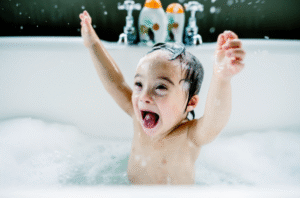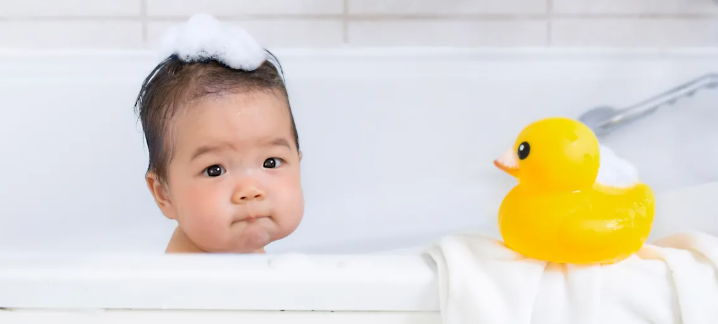How Often Should I Bathe My Newborn? Expert Tips
How frequently should a newborn be bathed? Discover the expert advice, the right time, and a safe baby bath schedule in this Hindi guide!
One of the most common questions in the minds of new parents is – “How often should a newborn baby bathe?” If you are also confused, relax!
The newborn’s skin is extremely fragile, and they don’t require daily bathing. In fact, the American Academy of Pediatrics recommends 2-3 times a week. But it doesn’t imply that you should ignore hygiene – every child is unique, and occasionally more care is necessary as well.
Today, on this blog, we’re going to inform you when to bathe your new baby the first time, whether or not sponge baths are safe, and what are the side effects of bathing daily. Bonus: We’re also going to provide you with a sample baby bath routine to do once a week that you can utilize!
Prepare for a calming, peaceful, and stress-free bath time — where the baby is content and you are too!
Why Bathing a Newborn is Different Than Older Babies
When the new baby is born, he must be sponge-bathed until his umbilical cord stump (portion of the umbilical cord) dries and falls off. In this situation, the baby is not sat in water whatsoever but is washed with a damp cloth.
Once the cord has dried and the navel region is fully alright, then tub bathing can begin, wherein the baby is bathed in a small tub of lukewarm water.
Why is it that a baby does not have to be bathed daily?
A baby’s skin is extremely sensitive. Daily bathing of the baby can dry the baby’s skin and strip away natural oils that protect the skin.
This is why doctors recommend bathing 2-3 times a week, as long as the baby is not very dirty or sweats heavily.
What is the impact of skin sensitivity and timing of umbilical cord stump baths?
Newborn skin is thin and highly sensitive. If we continue to expose them to soap and water over and over again, they can develop dryness and rashes.
Also, until the umbilical cord stump separates naturally, it is not advisable to bathe the baby in a tub bath. For now, it is advisable to give only a sponge bath so that there is no infection.
What is vernix and why should it not be washed off?
Vernix is a white, creamy coating that appears on the baby’s skin during development. Vernix is a natural moisturizer and acts as a defense against infection. An overwhelming majority of professionals opine that vernix must not be removed by scrubbing it away, but must be allowed to dry on its own. This maintains the baby’s skin moist and in a protective state.
How frequently should a newborn bathe?
Optimal Frequency: 2–3 Times a Week
In general, your new baby does not require bathing daily. Experts recommend bathing only two or three times a week. Newborn babies are not too dirty since they do not move around much inside and out and their skin is also very sensitive.
Bathing too frequently can make the skin dry.
Bathing your baby too much can strip natural oils from his skin. These oils keep their skin healthy and moisturized. When these oils fade away, the skin becomes dry and irritated. Newborn babies have extremely sensitive skin, so bathing more than required should be avoided.
Some of the things that can make you bathe more or less often
There are certain times when you might need your baby to bathe more or less often:
Spit-ups (vomiting): If your baby vomits a lot, you will need to bathe more often to clean that spot.
Diaper Blowouts (potty leak): When potty leaks from the diaper, you might need to bathe to wash that area well.
Skin Conditions (Skin problems): If your baby has a skin condition, like eczema, your doctor will let you know how often to bathe. In some conditions, less bathing is advised, and sometimes the doctor will advise bathing in a specific manner.
What Pediatricians and Dermatologists Say
Pediatricians (children’s doctors) and dermatologists (skin doctors) also tend to advise newborns to be bathed 2-3 times a week. He also emphasizes that you should handle the skin of your baby gently and use gentle, fragrance-free soap. If you have any questions regarding how often your baby needs to be bathed, consult your doctor. He can provide you with the best guidance based on your baby’s individual needs.
When to Give Baby’s First Bath
1. Timing of the First Bath Following Birth (WHO guidelines recommend 24+ hours)
We are thinking about bathing the baby as soon as it is born. However, the World Health Organization (WHO) recommends that the newborn must be bathed for the first time after at least 24 hours after delivery. The rationale behind this is that bathing immediately might decrease the temperature and sugar level of the baby.
If for any reason it is not possible to wait for 24 hours (e.g., hospital discharge is imminent), then one must wait at least 6 hours. This period is crucial for the comfort and health of the baby.
2. Waiting for the Umbilical Cord Stump to Fall Off
When the baby is born, there is a cord stump in its navel which falls off on its own after a few days. Until this umbilical cord stump falls off (usually 1–2 weeks), the baby should be given a sponge bath, not a direct water-soaked bath.
It is highly essential to ensure the cord stump stays dry so that infection can be avoided. We should not wet it because, if we do, bacteria will develop which might be detrimental to the baby. For this reason, waiting for the cord stump to dry and then fall off is the best practice.
3. Advantages of Postponing the First Bath
There are certain significant advantages of postponing the first bath:
Control of body temperature: Giving an immediate bath decreases the temperature of the baby, and it’s risky for them.
Protection of skin: There is a natural cream-like covering on the body of the baby known as vernix. It keeps the baby’s skin free from infection and keeps the skin moist. If we give the first bath prematurely, this vernix disappears.
Bonding and breastfeeding: By not bathing for the initial few hours, the bonding between the mother and baby becomes strong, and breastfeeding too begins in a smooth manner.
Less stress for baby: Bath time is stressful for a newborn baby. If done later, he gets accustomed a bit to the surroundings and is relaxed.
Sponge Bath vs. Tub Bath – What’s Safer for Newborns?
Both the sponge bath and tub bath are options available for newborn infants, but their application is based on the condition and age of the baby. A sponge bath is safer for the initial weeks until the umbilical cord stump of the baby dries off.
When to give a sponge bath
When the baby’s umbilical cord stump is intact, a sponge bath should be administered. This prevents the cord stump from getting wet and makes infection less likely. The cord stump commonly detaches within 1-2 weeks of giving birth, and during this time, a sponge bath is the most appropriate.
Step-by-step sponge bath technique
-Take a cotton cloth or soft towel wet it with slightly warm water and squeeze it.
-Place baby on a flat and safe surface, a bed, or a changing table (make sure to put a waterproof sheet underneath).
-Wipe the baby’s face, hands, feet, and body with a damp cloth.
-Clean the diaper area last, always in a front-to-back direction.
-After cleaning all over, pat the baby dry with a gentle towel.
-If you want, you may put a mild baby moisturizer on after the bath.
When to make the switch to a tub bath
When the baby’s umbilical cord stump drops off on its own (usually within 10-14 days), you can then start tub baths. The initial tub bath must be brief and delicate. The water level should be kept low (only 2-3 inches) and one hand should always be used to support the baby.
Safety advice for both methods
-Sponge Bath Safety Advice:
-Use warm water, but not extremely hot (optimal temp: 37°C).
–Don’t expose the baby entirely; allow them to feel snug and warm.
-Finish the bath fast so that the baby does not catch a cold.
Tub Bath Safety Precautions:
-Never leave baby unattended – not even for a second.
-Keep water low and hold the baby securely with your hands.
-Use a slip-proof baby tub.
-Prepare all products (soap, towel, clothes) in advance.
Keep baby warm by wrapping him/her right after bath.
Bathing Tips for Happy, Safe Bath Time
1. Preparing the bathing area
You must get everything ready before taking the bath. Select a warm room that is wind-free and at no time is cold or where there are distractions. Have all the things you need such as warm water, baby towel, mild baby soap, cotton balls, fresh clothes, and diapers in advance. This will prevent you from washing anything in the middle and your attention will remain solely on the baby.
2. Optimal water temperature (approximately 37°C / 98.6°F)
The temperature of the water for a newborn must not be too hot or too cold. The ideal temperature is 37°C or 98.6°F, which is the same as our normal body temperature. You can test the water by dipping your elbow or wrist — if it is not too hot and comfortable, then you can use it for the baby.
3. How to safely support your baby in the bath
When bathing a newborn baby, it is extremely crucial to hold him in position at the neck and head. Hold the baby’s head and neck with one hand and his body with the other hand. Do not leave the baby alone in the tub, even for a second. Slipping is always a possibility, so always hold both hands and take precautions.
4. Products to use (and avoid!) for newborn skin
Newborn skin is extremely sensitive, so always use gentle, fragrance-free, and hypoallergenic products. Use baby soap, shampoo, and lotion specially formulated for newborns. Avoid any products that have fragrance, alcohol, or harsh chemicals in them as these will irritate baby’s skin.
5. How to dry and moisturize your baby after a bath
After a bath, pat the baby dry gently by rubbing him/her on a soft towel. Don’t rub, but lightly tap with the towel to dry the skin. Then put some gentle baby moisturizer or lotion on it so that the skin doesn’t dry out. Putting moisturizer is particularly important during winter or dry climates so that the baby’s skin doesn’t dry out and remains soft and healthy.
Common Mistakes Parents Make While Bathing Newborns
Bathing too frequently
New parents believe that they should bathe their baby every day, but newborns do not need to be bathed every day. Their skin is too sensitive, and bathing them daily strips them of their natural skin oils that help shield them from dryness and rashes.
Optimal frequency: 2–3 baths a week is sufficient, provided the baby is not excessively dirty.
Harsh soaps or adult products
At other times, parents apply the same product to their baby as they use on adults, for example, regular body soap or shampoo. This is also incorrect because adult products have harsh chemicals that may cause skin irritation in the soft newborn skin.
Correct approach: Apply baby mild, fragrance-free soaps and shampoos that are specifically designed for newborns.
Failure to monitor water temperature
Most parents either leave the water hot or cold, which exposes the baby to burning or discomfort.
Optimal temperature: Lukewarm water (around 37°C or 98.6°F) is ideal. You can test the water by using your elbow or wrist — it should be neither cold nor hot.
Leaving the baby alone for even a fraction of a second
This is a significant safety hazard. Newborns must never be left unattended in the tub or bathing zone, even briefly. If the infant shifts just slightly, there’s potential for slipping, which can be harmful.
Tip: Have everything prepared in advance – towel, soap, diaper, clothing – so you don’t need to have them picked up at the beach.
Conclusion: Bathing Newborns with Confidence
Bathing your newborn doesn’t need to be a daily task — or a stressful one! Stick to 2–3 times a week, keep your baby warm and safe, and follow their cues. Every baby is different, so trust your instincts and consult your pediatrician if unsure. With a little preparation and patience, bath time can become a soothing ritual that you and your baby both enjoy!


